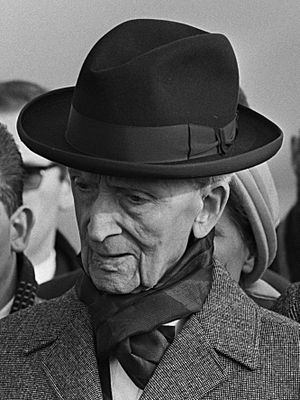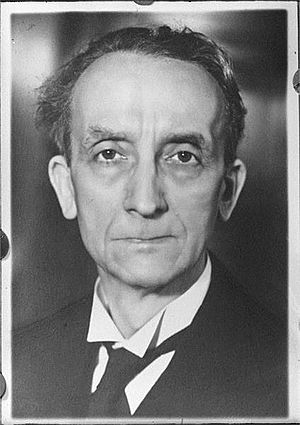Camille Huysmans facts for kids
Quick facts for kids
Camille Huysmans
|
|
|---|---|
 |
|
| Prime Minister of Belgium | |
| In office 3 August 1946 – 20 March 1947 |
|
| Monarch | Leopold III |
| Regent | Prince Charles |
| Preceded by | Achille Van Acker |
| Succeeded by | Paul-Henri Spaak |
| President of the Chamber of Representatives | |
| In office 27 April 1954 – 11 November 1958 |
|
| Preceded by | Frans Van Cauwelaert |
| Succeeded by | Paul Kronacker |
| In office 23 June 1936 – 21 April 1939 |
|
| Preceded by | Jules Poncelet |
| Succeeded by | Frans Van Cauwelaert |
| Personal details | |
| Born | 26 May 1871 Bilzen, Belgium |
| Died | 25 February 1968 (aged 96) Antwerp, Belgium |
| Political party | Socialist Party |
| Alma mater | University of Liège |
Jean Joseph Camille Huysmans (born as Camiel Hansen) was an important Belgian politician. He was born on May 26, 1871, and lived until February 25, 1968. He is best known for serving as the prime minister of Belgium from 1946 to 1947.
Contents
Camille Huysmans' Life Story
Early Life and Education
Camille Huysmans first studied German philology (the study of language in historical and cultural context) at the University of Liège. He worked as a teacher from 1893 to 1897 while he was finishing his advanced degree in German language studies.
Joining the Socialist Movement
Huysmans joined the Belgische Werkliedenpartij (BWP) when he was young. This was an early version of the Belgische Socialistische Partij (BSP), which was a socialist political party in Belgium. He worked as a journalist for many socialist newspapers until 1904. After that, he became very active in labour unions, which are groups that protect workers' rights.
International Work and Peace Efforts
From 1905 to 1922, Huysmans served as the secretary of the Second International. This was an organization that brought together socialist and labor parties from around the world. In this role, he met many important people, including Sun Yat-sen, who led China's first revolution in 1911.
One of Huysmans' main goals was to promote peace. At a Socialist Conference in Stockholm in 1917, during World War I, he argued strongly against continuing the war.
Fighting for the Dutch Language
Huysmans was a strong supporter of the Flemish movement. This movement aimed to protect and promote the Dutch culture and language in Belgium. He especially fought for Dutch to be used at the University of Ghent.
As the Minister of Arts and Education, he helped make it possible for Dutch to be used more widely. In 1911, he worked with Lodewijk De Raet, Frans Van Cauwelaert (a Catholic politician), and Louis Franck (a liberal politician) to propose a law. This law would make Dutch the main language at the University of Ghent. However, because of World War I, the university did not become a Dutch-speaking university until 1930.
World War II and Becoming Prime Minister
During World War II, Huysmans had to leave Belgium and went to London for safety. He again served as secretary of the Second International from 1939 to 1944.
After World War II, when he was 75 years old, he became the 34th Prime Minister of Belgium. He led a government that included socialists, liberals, and communists. However, his government did not have a strong enough majority in parliament, so it did not last very long. In the next government, he served as the Minister of Education.
Important Reforms as Prime Minister
During Huysmans' time as Prime Minister, his government made many important changes to help people.
- In October 1946, a special rule was made to keep workers safe in factories that made wire ropes.
- In December 1946, rules were put in place for health and safety in factories that made sugar and molasses alcohol.
- In January 1947, a law was passed to give a standard payment to children of workers who were disabled.
- Also in January and February 1947, new rules created a national office to help coordinate family allowances, which are payments to families with children.
- A law from February 1947 expanded family allowances for people who earned wages.
- Another rule that month allowed a national group for affordable housing to borrow a lot of money. This money was used to help build houses for miners.
Later Life and Legacy
Camille Huysmans remained very popular even when he was old. When he turned 80, about 100,000 people came to celebrate him. At 83, he became the chairman of the Chamber of Representatives, which is the lower house of the Belgian parliament. He was also a freemason, a member of a group called Les Amis Philanthropes in Brussels.
Huysmans is seen as a friend to the Jewish people. This is mainly because he was very welcoming to Jewish immigrants in Antwerp between 1920 and 1940. He also supported the Zionist movement, which worked to create a Jewish homeland. There are streets named after him in the cities of Netanya and Haifa in Israel.
Important Roles Camille Huysmans Held
- Councillor in Brussels (1908–1921)
- Education Schepen (a type of alderman) of Antwerp (1921–1933)
- Mayor of Antwerp (1933–1940 and 1944–1946)
- Councillor in Antwerp (1946–1968)
- Member of the lower house of parliament (1910–1965)
- Chairman of the lower house (1936–1939 and 1954–1958)
- Minister of Arts and Education (1925–1927)
- Prime Minister (1946–1947)
- Minister of Education (1947–1949)
Awards and Honours
 Belgium: Given the title of Minister of State by the King.
Belgium: Given the title of Minister of State by the King. Belgium: Member of the Royal Academy.
Belgium: Member of the Royal Academy. Belgium: Grand Cordon in the Order of Leopold (a high honour).
Belgium: Grand Cordon in the Order of Leopold (a high honour). Belgium: Knight Grand Cross in the Order of the Crown (another high honour).
Belgium: Knight Grand Cross in the Order of the Crown (another high honour).- Knight Grand Cross in the Swedish Order of the Polar Star in 1937.
- Commander of the Legion of Honour (a French award).
- Order of the British Empire (a British award).
Letters with Lenin
During his first time as secretary of the Second International, Camille Huysmans exchanged letters with Lenin between 1905 and 1914. Lenin was a very important leader of the Russian Revolution. These letters were later published in 1963.
See also
 In Spanish: Camille Huysmans para niños
In Spanish: Camille Huysmans para niños


